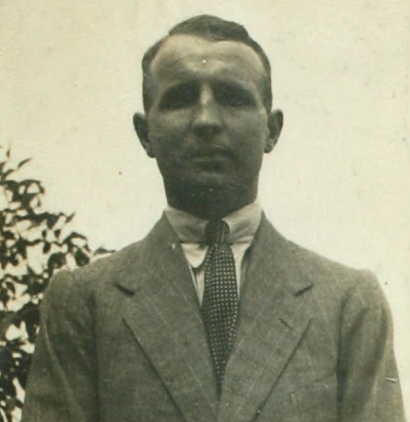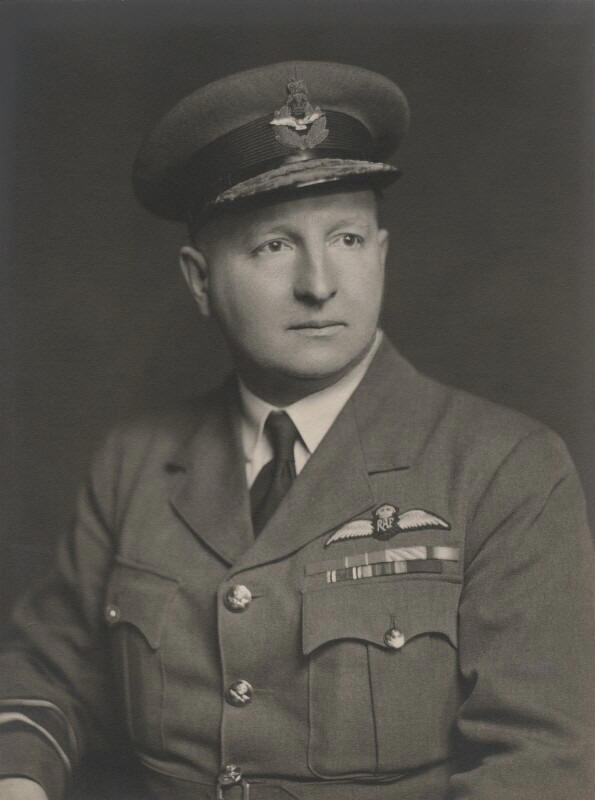Photograph (Far left) - taken from his RAeC Certificate
Photograph (left) - Sir Leslie Norman Hollinghurst
by Walter Stoneman
bromide print, March 1942
NPG x164124
Air of Authority - A History of RAF Organisation
Air Chief Marshal Sir Leslie Hollinghurst

 Leslie Norman
b: 2 Jan 1895
r: 27 Dec 1952
d: 8 Jun 1971
Leslie Norman
b: 2 Jan 1895
r: 27 Dec 1952
d: 8 Jun 1971
GBE - 1 Jan 1952 (KBE - 5 Jul 1945, CBE - 15 Aug 1944, OBE - 26 Jun 1931), KCB - 10 Jun 1948 (CB - 1 Jan 1942), DFC - 3 Dec 1918, MiD - 8 Sep 1933, MiD - 1 Jan 1941, DFC (US) - 27 Oct 1944, Leo, Cdr - 9 Oct 1945, BL - 1 Jan 1946, LoH, O - xx xxx 194?, C de G (F) - xx xxx 194?.
(Army):- Sap/Sig'n: 7 Sep 1914, Lce-Cpl: xx xxx xxxx, Cpl: xx xxx xxxx, (T) 2 Lt: 2 Apr 1916, (T) Lt: 1 May 1917,.
(RAF):- Lt: 1 Apr 1918, (G) Capt: 1 May 1919, Fg Off: 1 Aug 1919, Flt Lt: 1 Jan 1922, Sqn Ldr: 29 May 1929, Act Wg Cdr: xx xxx xxxx, Wg Cdr: 1 Jan 1936, Act Gp Capt (pd): 1 Jan 1939, Gp Capt: 1 Apr 1939, Act A/Cdre: xx Aug 1940?, (T) A/Cdre: 1 Mar 1941, Act AVM: 1 Jul 1941, A/Cdre: 14 Apr 1942 [1 Mar 1941], (T) AVM: 1 Dec 1942, Act AM: 6 Nov 1944 - 23 Aug 1945; 14 Sep 1945, (T) AM: 1 Jan 1946, AVM: 1 Jan 1946, AM: 1 Jul 1947, ACM: 15 May 1950.
Photograph (Far left) - taken from his RAeC Certificate
Photograph (left) - Sir Leslie Norman Hollinghurst
by Walter Stoneman
bromide print, March 1942
NPG x164124
7 Sep 1914: Sapper/Signaller, Royal Engineers.
6
Apr 1916:
Posted as Officer,
3rd Battalion, Middlesex Regiment.
22 Apr 1916: Embarked at Alexandria
25 Apr 1916: Arrived at Salonika
29 Apr 1916: Joined 3rd Battalion, Middlesex Regiment.
5-11 Sep 1916: Admitted to No 21 General Hospital (Septic knee)
7 Nov 1916: Admitted to No 40 Casualty Clearing Station (Gun shot wound to thigh)
8 Nov 1916: Admitted to No 21 General Hospital (Gun shot wound to thigh)
27 Nov 1916: Transferred to Base Depot and transferred to RFC
3 Dec 1916: Embarked for Egypt
6 Dec 1916: U/T Pilot, No 22 Reserve Sqn RFC.
7 Feb 1917: U/T Pilot, No 23 Reserve Sqn RFC.
16 Mar 1917: Embarked on HT 'Minnetonka' at Alexandria for UK
20 Mar 1917: Flying Officer, RFC.
30 Mar 1917: Attended Central Flying School.
xx May 1917: Test Pilot, No 7 Aircraft Acceptance Park.
xx xxx 1918: Test Pilot, No 1 Aircraft Supply Depot
xx xxx 1918: Test Pilot, No 2 Air Issues Section
xx Apr 1918: Pilot, No 87 Sqn RFC.
xx Jun 1919: Flight Commander, No 79 Sqn.
xx xxx xxxx: Pilot, No 48 Sqn.
15 Jun 1919: Pilot, No 5 Sqn.
12 Dec 1919: Awarded a Permanent Commission in the rank of Flying Officer.
31 Jan 1921: Supernumerary, RAF Depot.
31 Mar 1922: Adjutant, Boy's Wing - Cranwell
4 May 1924: Attended RAF Staff College.
6 Apr 1925: Air Staff, HQ Inland Area.
11 Apr 1927: Flight Commander, No 2 Sqn - Shanghai Defence Force.
5 Nov 1927: Flight Commander, No 26 Sqn.
17 May 1929: Officer i/c, No 1 Coast Defence Co-operation Flight
8 Oct 1929: Air Staff, HQ No 1 (Indian) Group.
9 Nov 1932: Officer Commanding, No 20 Sqn
xx xxx 1935: Directing Staff, RAF Staff College.
18 Jan 1938: Attended Imperial Defence College.
1 Jan 1939: Deputy Director of Peace Organisation.
xx xxx 1940: Principal Deputy Director of Organisation.
xx Aug 1940: Director of Organisation.
1 Jan 1941: Gazetted for rendering valuable services in connection with the war
1 Jul 1941: Director-General of Organisation.
2 Jul 1943: AOC, No 9 (Fighter) Group.
6 Nov 1943: AOC, No 38 (Airborne Forces) Group
6 Nov 1944: Air Marshal Commanding, Base Air Forces, ACSEA.
14 Sep 1945: Air Member for Supply and Organisation
1 Sep 1948: Inspector-General of the RAF
31 Oct 1949: Air Member for Personnel
Born in Essex he was a motor
mechanic before joining the
Royal Engineers as a Sapper/Signaller immediately after the outbreak of war in 1914.
In 1915 he took part in the Gallipoli campaign and was later wounded in
Salonika, being sent to Egypt for recuperation.
Whilst in Egypt, he received a commission as a 2 Lt in the Middlesex
Regiment in 1916. In
late 1916/early 1917 he transferred to the RFC, carrying out his initial flying training in Egypt
Opting to remain in the post-war RAF, he was awarded a permanent commission and was posted to No 5 Squadron, in which he served for three years in both Afghanistan and on the North West Frontier of India. Returning to Britain he became Adjutant of the Boy's Wing at Cranwell until he joined the 1924/5 course at the RAF Staff College. A spell as a staff officer with Inland Area was followed by a move to Shanghai as a flight commander of No 2 Squadron during the troubles in China in 1927. Back in Britain, he joined No 26 Squadron before being put in charge of No 1 Coast Defence Co-operation Flight. This flight was part of the Armament and Gunnery School and provided aircraft to tow targets for coastal batteries to practice against.
Returning to India, he joined the staff of No 1 (Indian) Group before assuming command of No 20 Squadron. A period as an instructor (directing staff) at Andover preceded his attendance at the Imperial Defence College in 1938. As war with Germany began to look more likely, Hollinghurst found himself concerned with the opposite as Deputy Director of Peace Organisation, but with such a requirement negated by the outbreak of the war, he was promoted to Director of Organisation and later Director-General.
During his time as Deputy Director of Peace Organisation he was a member of the committee that held talks in 1939 with delegates from Poland about the supply of Battles Hurricanes and Spitfires, but supplies failed to reach the country before the German victory.
In 1943, he returned to an operational command when he was appointed AOC, No 9 Group in Fighter Command which provided the air defence of the Western side of Britain.
Following the successful German use of airborne troops during t the early campaigns of the war and in Crete, the British had begun the recruitment and training of the own both parachute and glider borne. Initially these forces had been relatively small as little opportunity had existed for the employment. The RAF contribution to these forces had been the formation of No 38 Wing, which had been formed within Fighter Command to control the few dedicated Airborne Forces squadrons then available and to continue the development of tactics and procedures. However, with the build up of forces in preparation for the invasion of Normandy, it was clear that a vast increase in the strength of these airborne forces was necessary, resulting in the raising of No 38 Wing to Group status as No 38 (Airborne Forces) Group with Leslie Hollinghurst as it's first AOC. Never content to lead from behind a desk he often took part in operations, as on the night of 5 June 1944 when he flew with Sqn Ldr Merrick in an Albemarle carrying part of 22 Independent Parachute Company. In September 1944 during the Arnhem operation, he even supervised direct control over his fleet during the initial lift from a Stirling involved in the operation. Whilst planning for 'Market Garden' he had wanted to fly two waves on the first day, but was over-ruled by General Browning, one wonders if the operation would have been as disastrous if he had been allowed to do so.
At the end of 1944 he moved to south East Asia, where he assumed command of the newly formed HQ, Base Air Forces. This post was brought about by the move of the Supreme Commander and the Service C-in-C’s to a new HQ at Kandy in Ceylon as a result of the advances being made in the Burma campaign. His role was to control the operational, administrative and training functions in India itself, including liaison with the Indian Government, now made difficult for the Air C-in-C who was now 1,500 miles from Delhi. However, the dropping of the Atomic Bomb on 6 August 1945 brought the war in South East Asia to an earlier the expected end and he found himself being posted back to Britain and appointed to the Air Council as Air Member for Supply and Organisation. After three years as AMSO, he spent another year as Inspector-General of the RAF before rejoining the Air Council as Air Member for Personnel. Even in retirement he was called upon to chair committees into organisational, administrative and technical matters. His other major interest in retirement was the Boy Scout movement and from 1953 until 1965, he was the part-time Chairman of the National Industrial Fuel Efficiency Service. In 1971, he attended the anniversary celebrations of D-Day in Normandy and it was whilst traveling back from these on the 8th, that he collapsed and died.Citation for the award the of the Distinguished Flying Cross
“Lieut. Leslie Norman Hollinghunst, (Midd'x R.). (FRANCE)
Since 25th April this officer has destroyed four enemy aeroplanes and driven down one out of control. At all times he displays great determination and cool courage, notably on 20th 'September, when, although his petrol tank had been shot through and his machine badly damaged, he attacked and destroyed a Fokker biplane that was stalling to fire on another member of the patrol, thereby saving the life of a brother Officer. On numerous other occasions Lt. Hollinghurst by his gallantry has saved from disaster other members of his patrol.”
(London Gazette – 3 December 1918)
Citation for the award of Officer of the Order of the British Empire
"HOLLINGHURST, Leslie Norman, S/L, DFC
in connection with military operations on the Northwest Frontier of India during he period between April 23 and September 12, 1930"
(Source - Aeroplane of 7 July 1931)
This page was last updated on 16/03/25©
![]()
![]()